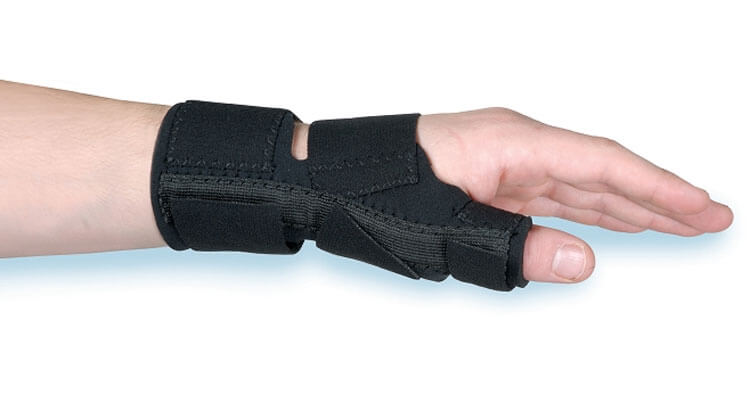Injury Rehabilitation and Training, Muscle Pain and Tendinopathy
Treatment Of De Quervain’s Tenosynovitis
Diagnosis Of Thumb Pain
A diagnosis of de Quervain’s tenosynovitis is typically a clinical one, made via the location of the pain and associated history of thumb stress, combined with a positive ‘Finkelstein’s test’. The Finkelstein’s test is performed through starting in the hitch hiking position and then making a fist with the thumb tucked on the inside of the fingers then subsequently bending the wrist down towards the floor. Patients with de Quervain’s tenosynovitis almost inevitably have a positive Finkelstein’s test experiencing thumb pain when performing this manoeuvre.
Another objective sign is that there will generally be palpable pain, that is pain when the hand is examined and pressure is applied on the thumb side of the wrist over the path of the inflamed tendons/tendon sheath complex. As previously mentioned the diagnosis is a clinical one meaning there is generally no need for and imaging or other investigations to make a diagnosis of de Quervain’s tenosynovitis. Investigations if necessary may be used when looking to rule out other potential causes of similar symptoms or when pain isn’t resolving with rest and treatment. In such circumstances the use of an X-ray can assess any osteoarthritic changes of the wrist or thumb, where as US imaging and MRI can examine soft tissue changes and add more information to the diagnostic picture.
Treatment Of De Quervain’s Tenosynovitis
Conservative (non-surgical) treatment for this tendon related thumb pain is usually successful, typically once stress on the tendon complex is removed the complaint tends to settle. In my experience it is best to address the issue prior to it becoming chronic, as the longer pain has been present for the harder it is to fix with de Quervain’s pain. Some of the approaches in the physiotherapy guided management of thumb pain include:
- Rest, as with many overload conditions rest plays a large roll in recovery. Avoiding repetitive thumb movements as much as possible, particularly avoiding pinching movements and gripping actions with the thumb will help the pain settle quicker.
- Frequently treatment for de Quervain’s tenosynovitis is the use of splinting, wrist braces, or taping to assist in stabilizing the thumb, unloading the tendon complex and enhancing the resting process can be a very effective tool in the short term management of tendon related thumb pain.
- The topical application of ice can be an effective pain management tool, at least in the acute and sub-acute phases.
- To help assist in and/or accelerate recovery the use of anti-inflammatory medication (oral, or topical creams, or patches) may be used to good effect.
- Cortisone injections may also be used in more stubborn conditions, when physiotherapy has failed to yield satisfactory results.
- In my experience with de Quervain’s tenosynovitis complaints related to pregnancy and nursing mothers. Symptoms in these situations are likely to settle either around the end the pregnancy, or once breast-feeding ceases.
- Your physiotherapist can assist you in reviewing how you use your wrist and thumb, offering suggestions how to adjust daily activities in an attempt to relieve stress on your thumb/wrist.
- Physiotherapists are also skilled at prescribing appropriate active management of the condition offering up in-clinic, or home exercises for your hand, wrist, arm to strengthen muscles, restore mobility, reduce pain and limit tendon irritation.
If thumb pain persists despite appropriate rest and treatment, surgery may be considered. A surgical procedure used is to open the sheath around the tendon in an attempt to release pressure on the tendons, allowing tissues to glide freely without causing pain. Personally my professional opinion and experience tells me that it is relatively uncommon to reach the point where surgical intervention is necessary. I have found that physiotherapy utilizing activity modification, support, manual therapy as appropriate, active rehabilitation exercises… is usually enough to settle even the most stubborn complaints.
Who Should I See For De Quervain’s Tenosynovitis Related Thumb Pain?
If you suspect you have de Quervain’s tenosynovitis I would suggest you see your local physiotherapist, or GP for confirmation of the diagnosis, and the implementation of an appropriate targeted management plan.
Disclaimer: Sydney Physio Clinic does not endorse any treatments, procedures, products mentioned. This information is provided as an educational service and is not intended to serve as medical advice. Anyone seeking specific advice or assistance regarding Treatment Of De Quervain’s Tenosynovitis should consult his or her general practitioner or physiotherapist or suitably skilled practitioner.


